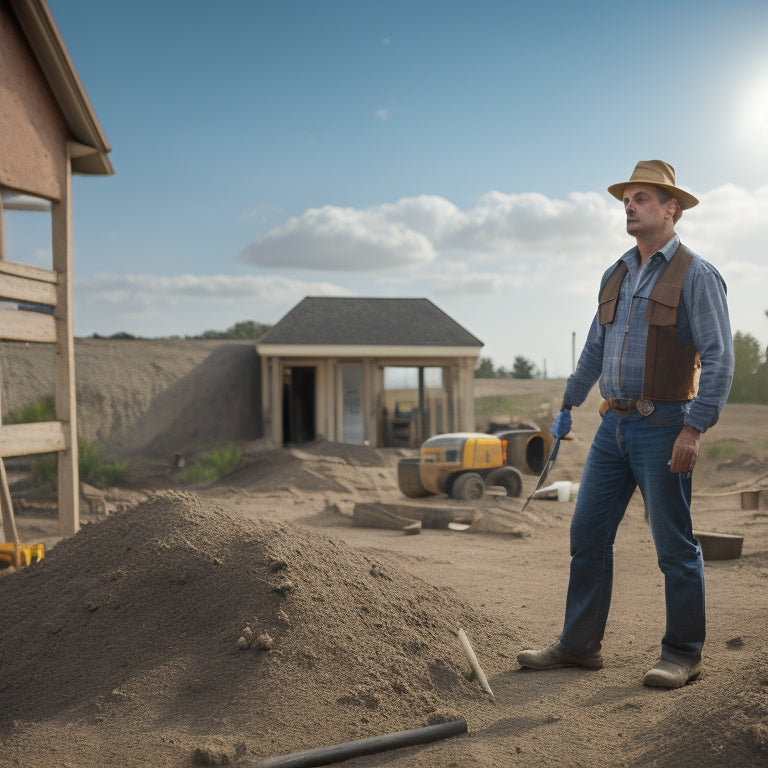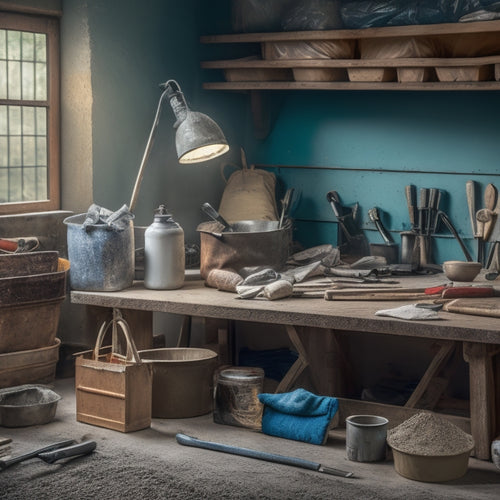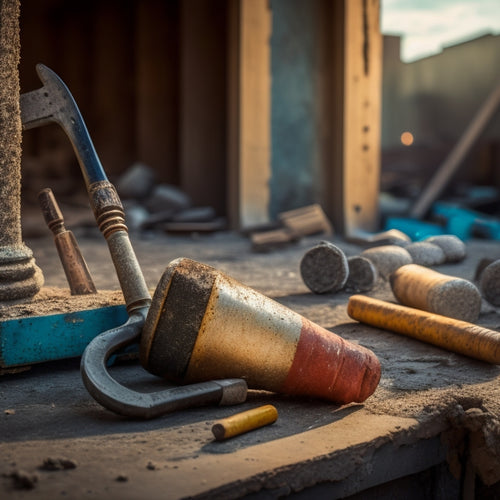
Concrete Foundation Building Tools for Homeowners' Success
Share
As you start your concrete foundation building project, it is vital to have the right tools to guarantee success. You'll need a mixing bucket, stick, and hoe for accurate concrete mixing ratios. A wheelbarrow, screed board, and spirit level will facilitate efficient foundation laying. For concrete finishing, a trowel, float, and broom will help achieve your desired finish. Additionally, concrete cutting tools like saws and grinders, as well as reinforcement materials like rebar and fiber mesh, are essential for structural integrity. With the right tools and techniques, you'll be well on your way to a successful project – and there's more to learn about each of these important elements.
Key Takeaways
• Essential mixing tools, like mixing buckets and measuring tapes, ensure accurate concrete ratios for a strong foundation.
• Foundation laying equipment, such as wheelbarrows and screed boards, facilitates efficient concrete pouring and leveling.
• Concrete finishing tools, including trowels and floats, help achieve desired surface textures and finishes.
• Reinforcement materials, like rebar and fiber mesh, add strength and durability to the concrete foundation.
• Proper curing and sealing techniques, including moisture control and sealant application, protect the foundation from water damage and ensure long-term performance.
Essential Concrete Mixing Tools
You'll need a set of essential concrete mixing tools to guarantee your mixture is consistently strong and workable. A sturdy mixing bucket or drum is a must, as it'll help you achieve the right mixing ratios.
Invest in a reliable mixing stick or paddle, designed for heavy-duty use, to ensure thorough blending of cement, sand, and aggregate. A mixing hoe or trowel will come in handy for scraping the sides and bottom of the bucket.
Don't forget a measuring tape or scoop to accurately measure your materials, and a water meter or bucket to achieve the ideal mixing ratio.
Mastering various mixing techniques, such as the 'mix-and-match' or 'slump' method, will also enhance your concrete's quality. Having these tools at your disposal will allow you to perfect your mixing ratios and techniques, resulting in a robust and durable concrete foundation.
Foundation Laying Equipment Essentials
With the mixed concrete ready, it's time to focus on the specialized equipment necessary for laying a solid foundation.
This includes a sturdy wheelbarrow or concrete buggy to transport and pour the concrete efficiently. You'll also need a screed board or tamping tool to level and compact the concrete. A spirit level guarantees the foundation is perfectly level, while a laser level helps you achieve precise grading.
Don't forget a set of foundation inspection techniques to verify the foundation's integrity, such as checking for cracks, unevenness, and proper drainage.
Before pouring the concrete, you'll need to prepare the soil using proper soil preparation methods, such as compacting and grading the soil. This guarantees a stable base for your foundation.
A plate compactor or hand tamper is essential for compacting the soil, while a rake or shovel helps with grading. Additionally, you may need a soil testing kit to determine the soil's bearing capacity and moisture content.
Concrete Finishing Tool Kit
Once the concrete is poured and set, finishing tools come into play to achieve the desired texture, smoothness, and appearance for your foundation.
You'll need a concrete finishing tool kit that includes essential tools to achieve the desired finish. A trowel is a must-have for smoothing out the concrete surface, and a float helps to remove excess water and achieve an even texture. For a more textured finish, you'll use a broom or a stamper to create the desired pattern.
When it comes to finishing techniques, you can choose from various options, such as a smooth finish, a broom finish, or a stamped finish. Each technique requires specific tools and techniques to achieve the desired result.
You'll also need to take into account texture options, such as a matte or glossy finish. Depending on your desired outcome, you may need to use a combination of tools and techniques to achieve the perfect finish.
With the right concrete finishing tool kit and a solid understanding of finishing techniques, you'll be able to achieve a professional-looking finish that enhances the appearance of your foundation.
Building Concrete Walls Efficiently
To build concrete walls efficiently, it's essential to optimize your workflow by mastering the art of concrete placement, consolidation, and finishing. You'll need to guarantee that your concrete mixture is of high quality, with the right consistency and strength to support the structural integrity of your wall.
Here are some key considerations to keep in mind:
-
Proper Wall Insulation Techniques: Confirm that your wall insulation is installed correctly to prevent heat loss and moisture damage.
-
Structural Integrity Assessments: Conduct regular assessments to identify any potential weaknesses or defects in your wall.
-
Optimized Concrete Placement: Use the right equipment and techniques to place concrete efficiently, minimizing waste and reducing labor costs.
- Effective Consolidation and Finishing: Use specialized tools and techniques to consolidate and finish your concrete, guaranteeing a smooth, even surface.
Must-Have Concrete Cutting Tools
Must-Have Concrete Cutting Tools
You'll need to precision-cut concrete blocks or slabs to guarantee a snug fit and maintain the structural integrity of your wall, making concrete cutting tools an indispensable part of your arsenal. When it comes to concrete cutting, you'll want to invest in high-quality tools that can handle the job efficiently and effectively.
Here are some essential concrete cutting tools you should take into account:
| Tool | Description | Recommended Use |
|---|---|---|
| Concrete Saws | Ideal for making straight cuts in concrete | Cutting concrete blocks, slabs, or walls |
| Diamond Blades | Designed for precision cutting and can be used with various power tools | Cutting curves, corners, or intricate designs |
| Concrete Grinders | Used for grinding and polishing concrete surfaces | Smoothing out rough edges, removing old adhesive |
| Demolition Saws | Heavy-duty saws for breaking up concrete | Demolishing old concrete structures or foundations |
When choosing concrete cutting tools, make sure to take into account factors such as power, speed, and durability. Remember to always follow safety guidelines and manufacturer instructions to guarantee a successful and injury-free project.
DIY Concrete Forming Tools
With your concrete blocks or slabs cut to size, you're now ready to focus on shaping and molding them into the desired form using DIY concrete forming tools. This stage requires attention to detail and the right tools to achieve the desired shape and structure.
To master concrete forming techniques, you'll need the following DIY forming materials:
-
Form liners: These are used to create textured or patterned surfaces, adding an aesthetic touch to your concrete foundation.
-
Form ties: These hold the formwork in place, ensuring it doesn't shift or deform during the concrete pouring process.
-
Form release agents: These prevent the concrete from bonding to the formwork, making it easier to remove once the concrete has set.
- Formwork accessories: These include items like formwork brackets, wedges, and clamps, which help secure and align the formwork.
Concrete Reinforcement Materials
Reinforcing your concrete foundation with the right materials is essential to its strength, durability, and overall structural integrity.
You'll need to choose the correct reinforcement materials to guarantee your foundation can withstand external forces like wind, earthquakes, and soil pressure.
The most common reinforcement materials used in concrete foundations are rebar (short for reinforcing bar) and fiber mesh. Rebar is a steel bar that's embedded in the concrete to provide added strength and resistance to cracking. Fiber mesh, on the other hand, is a network of synthetic or steel fibers that's dispersed throughout the concrete to improve its tensile strength.
When it comes to reinforcement techniques, you can opt for a single layer of rebar, multiple layers, or a combination of rebar and fiber mesh.
The key is to select the right technique and materials for your specific project, taking into account factors like soil type, climate, and building codes.
Leveling and Grading Tools
As you prepare to pour your concrete foundation, you'll need to ascertain the site is accurately leveled and graded to prevent uneven settling and structural weaknesses. This vital step guarantees your foundation is stable and can support the weight of your home. To achieve this, you'll need the right leveling and grading tools.
Here are some essential tools to have in your arsenal:
-
Laser Level: A laser level projects a level line or plane, allowing you to accurately check the site's elevation and make adjustments as needed.
-
Grade Rod: A grade rod is a long, sturdy rod with markings that indicate different elevations, helping you measure and adjust the site's grade.
-
Tamping Tool: A tamping tool compacts soil and gravel, creating a stable base for your foundation.
- Surveying Equipment: Surveying equipment, such as a transit level or theodolite, helps you determine the site's elevation and ascertain it's accurately graded.
Concrete Curing and Sealing
As you move forward with concrete curing and sealing, you'll need to take into account the methods you'll use to control moisture, the techniques you'll employ to apply sealants, and the options you'll choose from among various curing compounds.
These factors will greatly affect the long-term durability and performance of your concrete foundation.
Moisture Control Methods
Applying effective moisture control methods, including concrete curing and sealing, is essential to prevent water infiltration and guarantee the long-term durability of your concrete foundation. As a homeowner, you need to verify that your foundation is protected from moisture, which can lead to structural damage and costly repairs.
To achieve this, you'll need to implement the following moisture control methods:
-
Install moisture barriers: These are impermeable layers that prevent water from seeping into your foundation. They can be applied to the exterior of the foundation wall or beneath the slab.
-
Implement drainage solutions: These include features like French drains, swales, and gutters that direct water away from your foundation.
-
Use waterproofing coatings: Apply a waterproofing coating to the foundation walls to prevent water infiltration.
- Verify proper grading: Verify the ground surrounding your foundation slopes away from the structure to prevent water accumulation.
Sealant Application Techniques
When it comes to guaranteeing the long-term integrity of your concrete foundation, how you apply concrete sealants is just as essential as the type of sealant you choose.
You'll want to select the right application technique to match your chosen sealant type. For example, acrylic and polyurethane-based sealants are best applied using a low-pressure sprayer or roller, while silane and siloxane-based sealants require a higher-pressure sprayer. Make certain to follow the manufacturer's instructions for application rates, as over- or under-application can compromise the sealant's effectiveness.
Before applying the sealant, guarantee the concrete surface is clean, dry, and free of contaminants. Remove any existing coatings, oils, or dirt, and fill any cracks or joints.
Apply the sealant in a consistent, even layer, working in sections to maintain even coverage. Use a clean, lint-free cloth or foam brush to spread the sealant, and avoid applying it in direct sunlight or high temperatures.
Curing Compound Options
You'll need to select a suitable curing compound to prevent moisture loss and promote proper hydration of your freshly poured concrete foundation. This essential step in concrete curing and sealing guarantees your foundation develops the necessary strength and durability.
When choosing a curing compound, consider the following options:
-
Acrylic-based compounds: These are water-based, easy to apply, and provide a moderate level of moisture retention.
-
Wax-based compounds: They offer excellent moisture retention, are easy to apply, and can be used on both vertical and horizontal surfaces.
-
Silane-based compounds: These are ideal for exterior applications, as they provide excellent protection against water, salt, and other corrosive substances.
- Siloxane-based compounds: They offer superior protection against water and chemicals, making them suitable for high-traffic areas or harsh environments.
Safety Gear for Concrete Work
By donning the right safety gear, you greatly reduce the risk of injury or illness when working with concrete, which can be hazardous due to its caustic nature and heavy weight. As a homeowner, it's vital to prioritize personal protective equipment (PPE) to guarantee a safe working environment.
Start with hazard awareness by identifying potential risks such as skin irritation, respiratory problems, and physical harm from heavy concrete slabs.
Invest in essential safety gear, including gloves, safety glasses, and a dust mask. Gloves protect your hands from alkaline burns and abrasions, while safety glasses shield your eyes from flying debris and chemical splashes. A dust mask prevents inhalation of concrete dust, which can cause respiratory issues.
Don't forget to wear long-sleeved shirts, long pants, and closed-toe shoes to prevent skin exposure. Additionally, consider a hard hat and steel-toed boots if you're working with heavy concrete structures.
Frequently Asked Questions
Can I Use a Regular Drill for Mixing Concrete?
You're wondering if you can use a regular drill for mixing concrete. While it's technically possible, it's not the most efficient or effective approach.
A regular drill lacks the torque and power needed to handle thick concrete mixes.
Instead, consider using a paddle mixer or drill attachments specifically designed for concrete mixing. These tools are built to handle the heavy demands of mixing concrete, ensuring a smooth and consistent finish.
Do I Need a Professional to Lay My Foundation?
As you stand at the threshold of your dream home, the foundation represents the roots that will hold it sturdy.
But, can you really pour your heart into laying it yourself? While a DIY foundation may seem tempting, it's a recipe for disaster.
One misstep can lead to foundation mistakes that'll leave your home crumbling.
Don't risk it – a professional's expertise is the solid ground you need to guarantee a strong, lasting foundation that'll support your dreams for years to come.
How Long Does It Take for Concrete to Fully Cure?
When you pour concrete, you're keen to see it set. But how long does it take to fully cure?
The curing process typically takes 28 days, but it's affected by temperature. Ideal temperatures range from 50°F to 80°F (10°C to 27°C). If it's too hot or cold, curing slows down.
You'll see initial set within 24-48 hours, but full strength takes time. Be patient, and your concrete will reach its maximum potential.
Can I Use Wooden Boards for Concrete Forming?
Imagine a canvas of wooden boards, waiting to be transformed into a sturdy concrete form.
Can you use wooden boards for concrete forming? Yes, you can!
Opt for durable wooden board types like 3/4-inch plywood or oriented strand board (OSB) for concrete form construction. These boards can withstand the pressure and weight of freshly poured concrete.
Guarantee a smooth finish by sealing the boards with a release agent and properly fastening them to the formwork.
Is It Necessary to Reinforce All Concrete Structures?
You're wondering if it's necessary to reinforce all concrete structures. The answer is, it depends on the project's requirements and loads.
Reinforcing concrete provides benefits like added strength, durability, and resistance to cracking. You'll typically use one or a combination of reinforcement types, such as rebar, fiber mesh, or post-tensioning cables.
While not all structures require reinforcement, it's essential for those subjected to heavy loads, harsh environments, or high stress.
Conclusion
You've got the concrete foundation building tools to lay a solid groundwork for your project.
Now, it's time to 'hammer out' the details.
With the right equipment and materials, you're well on your way to a sturdy structure that'll stand the test of time.
Remember, a strong foundation is the backbone of any successful build, so don't skimp on the essentials.
You've got this!
Related Posts
-

10 Must-Have Tools for Small Concrete Projects
When tackling small concrete projects, you'll need a range of essential tools to achieve professional-grade results. ...
-

10 Best Tools for Sealed Concrete Finishing Success
When it comes to sealed concrete finishing success, you need a robust arsenal of specialized tools. Start with essent...
-

5 Tips for Splitting Concrete With Second-Hand Tools
When splitting concrete with second-hand tools, you'll need to be strategic to avoid wasting time, money, and putting...


